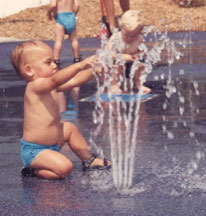
Vol. XI, No. 1, January-June 2012
Creating Healthy, Sustainable Infant and Toddler Gardens
Educating parents and caregivers about the importance of healthy and sustainable infant and toddler gardens is imperative...
Educating parents and caregivers about the importance of healthy and sustainable infant and toddler gardens is imperative. Getting infants and toddlers outdoors should be a daily activity but what are some of the unique considerations of creating gardens for children this young?
Infants and toddlers experience the natural environment differently than adults or preschool children. Adults typically see nature as a background for what they are doing. Children and infant/toddlers experience nature not as a background for events but as a stimulus for experiences. The world of nature is not a scene or even a landscape but just a sensory experience. Infants and toddlers will want to interact with their outdoor environment. Plants speak to all the senses of infants and toddlers.
Because infant and toddler’s have developing neurological systems it is very important that everything in the garden be non-toxic and healthy. Babies put their hands in their mouths 30-50 times per hour so they are more vulnerable to environmental toxins. Besides, they spend their time on the ground where chemicals are commonly used, either on the lawn or on surfacing materials made of chemicals. I have heard teachers obsess over the choking dangers of natural engineered wood fiber but at the same time put down another type of surfacing without looking at the health risks involved for children this young.

Any type of surfacing including rubberized, plastic grass and certainly the product called “pour in place”, should be tested for lead content prior to it’s use with young children. The vendor should have this information on file in the form of a third party lead testing certificate. They should also have a Materials Data Safety Sheet (MSDS) as this is a requirement for workplace and product safety for those who are installing this product. This sheet will provide the chemical content of the product; it’s toxicity and its health affect on humans. Please read the sheet!!! If a worker has to wear a respirator to install any type of product, do you really want infants and toddlers with developing neurological systems to be on this product at all? If your vendor cannot provide this information on any product you are planning on purchasing, my advice would be to find another vendor who can. Infants and toddlers are relying on us to protect their health and we can never be too safe.
Another health consideration that I have seen with very young children is the use of plastic or artificial grass. While it might seem cool to have green grass during the drought of the summer please remember that plastic grass does have some risks besides possibly containing lead. Sports owners and landscape architects can tell you that a sunny day can turn a lush oasis into a dangerously hot surface. I have been told that lawn temperatures on some artificial grass can be as high as 30-50%F above the air temperature. I am also told that this fake grass can take a surprising amount of maintenance according to landscape architects who have installed it. It has to be hosed down or odors are contained in the grass and if it gets too dirty you may find yourself back to weeding.
Plants used with infants and toddlers should all be checked for toxicity of all plant parts. Some plants have poisonous leaves, some poisonous bark, and some poisonous roots. Check several different sources for plant toxicity. Also look at the safety aspects of the plant materials-are there any parts that could become choking hazards, any parts that can poke/protrude? Select native plants for your area so that they are low maintenance. Use a variety of textures and colors. If you choose to use blooming or scented plants, put them where children this young cannot interact with bees.
Listed below are some tips to use on designing play gardens for infants and toddlers:
- Check your soil for any contaminants including lead content
- Use plants to separate play spaces and provide a sense of enclosure
- Use large shade trees to provide instant protection from the sun
- Use plants to create privacy or to screen toxins from the air
- Use plants and equipment that are scaled down for infants and toddlers
- Provide for varying level changes but you will need ADA access if children using the yard are over two years old
- Consider storage and maintenance as part of your design criteria
- Follow all safety and licensing requirements
Designing your infant/toddler garden is complex so care should be taken to find the right person to assist you with the design. Good design will not only help the children feel ready to play but can support both the staff’s and parent’s needs.
While you might not be able to implement every suggestion in this article on maintaining healthy outdoor environments for infants and toddlers, every one can do something to help safeguard infant and toddler’s health. Start small and make a few changes and be sure to educate parents along the way. Parents also need support in better understanding how to make their home gardens or outdoor play space healthier for their child.

